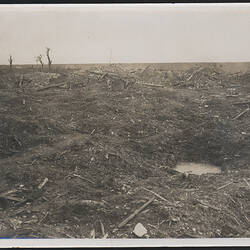Summary
Black and white photographic print.
Attached to a small notebook used as a photograph album, containing 55 black and white photographs of ANZAC soldiers in Egypt, Mudros and Gallipoli during World War I. The photographs were taken by an Australian soldier, Sergeant John Lord or one of his friends (to be verified). John Lord served in the 13th Field Ambulance and returned to Australia shortly after the end of the War in 1919.
The album was one of many souvenirs brought back to Australia after World War I by Lord. Part of a larger collection of photograph albums, images, documents and World War I memorabilia donated by John Lord to Museum Victoria.
Image depicting a trench at Lone Pine, the occupants of the trench are behind a curtain. During the Battle of Lone Pine seven Victoria Crosses were awarded to Australians.
Description of Content
Looking down a trench towards what seems to be a dead end. Both 'walls' of the trench are lined with sandbags. The upper portion of the photograph is sky and across the middle of the photograph are what appears to be two wires suspended above the trench.
Physical Description
Black and white photograph, mounted in a small, blue, army-issued notebook used as a photograph album.
Significance
This photograph is in a very significant album which includes a number of excellent photographs of Australian soldiers at Gallipoli and surrounding areas. Some of these are particularly clear and well-composed - for example, 'Rest Gully Anzac' shows hundreds of soldiers sitting and standing around talking and a valley with lots of dugouts and shelters. 'Old Kit etc at Anzac Ordnance Stores 1915' is another clear photograph, ,showing rubbish that the Anzacs generated at Gallipoli. Many of the photographs were taken when the weather was hot, but there are also a number of images taken in the snow. Another, 'Extreme Right of Anzac' demonstrates the steepness of the terrain and the mixture of clothing that the soldiers wore. All of the photographs appear to have been taken at times when the photographer was 'off duty', since the images are of the landscape or soldiers at rest.
More Information
-
Collection Names
Military Memorabilia Collection, John Lord Collection, Returned and Services League (RSL) Collection
-
Collecting Areas
-
Acquisition Information
Donation from J. Lord, 24 Feb 1986
-
Place & Date Depicted
-
Previous Owner
Sergeant John Lord
Private John Lord was originally identified as the photographer of the album, but as there is no record of him serving on Gallipoli, and images in the album depict Gallipoli, the photographer is probably an unknown soldier. -
Format
Photograph, Black & White
-
Inscriptions
Hand-written in pencil on the support underneath the photograph: '?ourer of ?rench / Lone Pine' Hand-written in pencil on the back of the photograph: 'A ?ourer of a first line / trench. The occupants are / behind the curtain looking / towards the (next few words are difficult to read)'
-
Classification
-
Category
-
Discipline
-
Type of item
-
Image Dimensions - Photograph
80 mm (Width), 107 mm (Height)
-
Image Dimensions - Photograph album page
102 mm (Width), 145 mm (Height)
-
Keywords
Australian Army, Militaria: Australian, Military Memorabilia, Wars & Conflicts, World War I, 1914-1918


